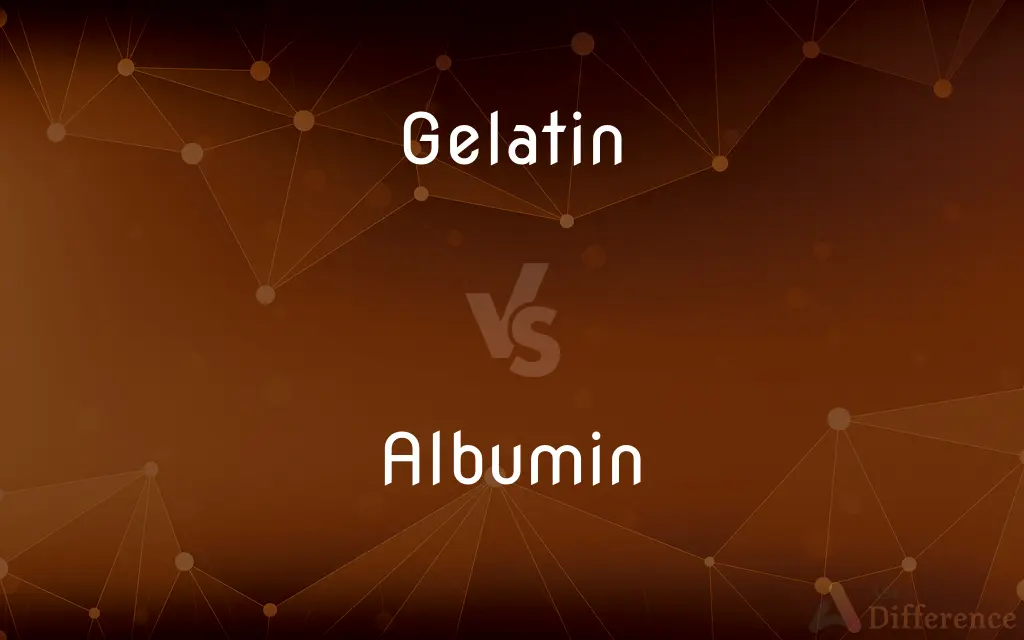Gelatin vs. Albumin — What's the Difference?
By Fiza Rafique & Maham Liaqat — Updated on April 27, 2024
Gelatin is a protein derived from collagen in animal parts, used for gelling in foods, while albumin, primarily found in egg whites and blood, functions as a stabilizer and in nutrient transport.

Difference Between Gelatin and Albumin
Table of Contents
ADVERTISEMENT
Key Differences
Gelatin is obtained by boiling animal parts like bones and skin, which causes the collagen to break down into gelatin. On the other hand, albumin is naturally occurring in animal tissues and fluids, especially in eggs and blood serum, where it serves different functions including maintaining osmotic pressure and pH balance.
In the culinary world, gelatin is widely used as a thickening agent in desserts such as jellies and puddings due to its ability to form gels at room temperature. Albumin, however, is often used in baking and meringue preparation because of its excellent foaming properties.
Nutritionally, gelatin is praised for its high content of amino acids, which are beneficial for skin, hair, and joint health. Conversely, albumin is a complete protein source, providing all essential amino acids required for body maintenance and repair.
Gelatin dissolves in hot water and sets into a gel upon cooling, which is reversible by reheating. Albumin does not set into a gel but coagulates when heated, which is an irreversible process used to stabilize textures in heated foods like meringues and baked goods.
Comparison Chart
Source
Collagen from animal bones/skin
Mainly egg whites and blood serum
ADVERTISEMENT
Culinary Use
Thickening agent in desserts
Foaming agent in baking
Nutritional Benefit
High in specific amino acids
Complete protein source
Physical Property
Forms gels, reversible with heat
Coagulates irreversibly with heat
Application
Food industry, medical capsules
Medical treatments, biochemistry
Compare with Definitions
Gelatin
Used in photography for film coating.
The gelatin layer on film helps adhere various chemicals.
Albumin
Used to stabilize food foams, like meringues.
Albumin helps meringues retain their structure and not collapse.
Gelatin
Employed in cosmetic products.
Gelatin is a common ingredient in face masks for its smoothing properties.
Albumin
Acts as a protein standard in laboratory experiments.
Albumin is used to calibrate assays in biochemistry labs.
Gelatin
Component in capsules and gel caps in pharmaceuticals.
Gelatin capsules dissolve easily in the stomach.
Albumin
Functions as a carrier for substances in the blood.
Albumin transports hormones and vitamins throughout the body.
Gelatin
Used as a binder in match heads and sandpaper.
Gelatin binds the components of a match head for consistent ignition.
Albumin
Medical use includes blood volume expansion.
Albumin solutions are administered to critically ill patients.
Gelatin
A protein obtained from collagen in animal parts, used as a gelling agent.
Gelatin is essential for making jellies firm.
Albumin
Albumin is a family of globular proteins, the most common of which are the serum albumins. All the proteins of the albumin family are water-soluble, moderately soluble in concentrated salt solutions, and experience heat denaturation.
Gelatin
Gelatin or gelatine (from Latin: gelatus meaning "stiff" or "frozen") is a translucent, colorless, flavorless food ingredient, commonly derived from collagen taken from animal body parts. It is brittle when dry and gummy when moist.
Albumin
(protein) Any of a class of monomeric proteins that are soluble in water, and are coagulated by heat; they occur in egg white, milk etc; they function as carrier protein for steroids, fatty acids, and thyroid hormones and play a role in stabilizing extracellular fluid volume.
Gelatin
A colorless or slightly yellow, transparent, brittle protein formed by boiling the specially prepared skin, bones, and connective tissue of animals and used in foods, drugs, and photographic film.
Albumin
A simple water-soluble protein found in many animal tissues and liquids
Gelatin
Any of various similar substances.
Gelatin
A jelly made with gelatin, used as a dessert or salad base.
Gelatin
A thin sheet made of colored gelatin used in theatrical lighting. Also called gel.
Gelatin
A protein derived through partial hydrolysis of the collagen extracted from animal skin, bones, cartilage, ligaments, etc.
Gelatin
An edible jelly made from this material.
Gelatin
A thin, translucent membrane used as a filter for photography or for theatrical lighting effects.
Gelatin
Animal jelly; glutinous material obtained from animal tissues by prolonged boiling. Specifically (Physiol. Chem.), a nitrogeneous colloid, not existing as such in the animal body, but formed by the hydrating action of boiling water on the collagen of various kinds of connective tissue (as tendons, bones, ligaments, etc.). Its distinguishing character is that of dissolving in hot water, and forming a jelly on cooling. It is an important ingredient of calf's-foot jelly, isinglass, glue, etc. It is used as food, but its nutritious qualities are of a low order.
Gelatin
A colorless water-soluble glutinous protein obtained from animal tissues such as bone and skin
Gelatin
An edible jelly (sweet or pungent) made with gelatin and used as a dessert or salad base or a coating for foods
Gelatin
A thin translucent membrane used over stage lights for color effects
Common Curiosities
What is gelatin made from?
Gelatin is derived from the collagen found in animal bones and skin.
How does albumin function in the body?
Albumin maintains osmotic pressure and pH balance, and transports substances.
Can vegetarians consume gelatin?
No, vegetarians avoid gelatin as it is derived from animal parts.
What role does gelatin play in pharmaceuticals?
It is used to make capsules that are easy to swallow and digest.
What are the health benefits of consuming gelatin?
It supports skin, hair, and joint health through its amino acids.
What are the dietary sources of albumin?
Major dietary sources of albumin are eggs, especially the egg whites, and meats.
How does the body produce albumin?
Albumin is primarily synthesized by the liver.
How does gelatin affect food texture?
Gelatin gives food a firm, gel-like texture that is reversible when heated.
How does albumin contribute to baking?
It acts as a stabilizer and helps in achieving firm and stable foams.
Is albumin a complete protein?
Yes, it provides all essential amino acids necessary for the body.
Can gelatin be used in vegan products?
No, gelatin is animal-based, but alternatives like agar-agar are used in vegan products.
What types of desserts commonly use gelatin?
Gelatin is commonly used in jellies, mousses, and puddings.
Are there any allergies associated with albumin?
Some individuals may have allergies to egg albumin.
How does gelatin work in cosmetics?
It acts as a skin conditioner and humectant in various cosmetic products.
Share Your Discovery

Previous Comparison
Basophil vs. Eosinophil
Next Comparison
Ultrabook vs. LaptopAuthor Spotlight
Written by
Fiza RafiqueFiza Rafique is a skilled content writer at AskDifference.com, where she meticulously refines and enhances written pieces. Drawing from her vast editorial expertise, Fiza ensures clarity, accuracy, and precision in every article. Passionate about language, she continually seeks to elevate the quality of content for readers worldwide.
Co-written by
Maham Liaqat













































